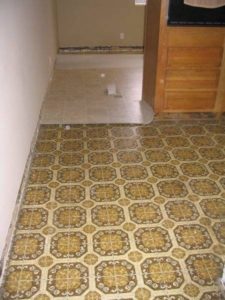 Linoleum flooring removal is a tough job. The good news is you don’t need specialized contractor skills. But, it does require a whole bunch of time and effort to get it done right. In fact, this is one of the most labor-intensive projects to tackle. However, this doesn’t mean you can do it on your own. Although, you will need some help to get it done and quite a bit of time, to boot. With some heavy elbow grease and a few common tools, you can do linoleum flooring removal in practically any space. So, read on to learn the basic steps of removing a linoleum floor covering.
Linoleum flooring removal is a tough job. The good news is you don’t need specialized contractor skills. But, it does require a whole bunch of time and effort to get it done right. In fact, this is one of the most labor-intensive projects to tackle. However, this doesn’t mean you can do it on your own. Although, you will need some help to get it done and quite a bit of time, to boot. With some heavy elbow grease and a few common tools, you can do linoleum flooring removal in practically any space. So, read on to learn the basic steps of removing a linoleum floor covering.
Linoleum Flooring Disposal
Like other types of engineered flooring, linoleum can be manufactured to look like wood flooring, stone flooring, or practically any other type of flooring material. Another big advantage to linoleum is that it is super easy to clean and maintain. However, though it’s got only a few negatives, like the fact that it is susceptible to damage from sharp objects.
One of the most frustrating home remodeling tasks is trying to remove an old linoleum or vinyl floor. Even when the linoleum is pulled off, things only get worse. Now you’re faced with gobs of old glue that seem harder than meteorites all over the floor. —Improvenet.com
One of its most problematic attributes is the fact that linoleum does not typically age well. It generally becomes brittle over time (and usually discolors, as well). Which means it’s harder to take up off the subfloor because brittle linoleum will break into small pieces, making it more difficult to remove as a whole.
Union City Linoleum Flooring Removal
Also, another obstacle is how it’s installed. Typically, linoleum is glued down to a subfloor. Which means, unlike most residential carpet, which is tacked down along the edges, it’s very hard to pull it up. So, here’s an overview of how to do linoleum flooring removal:
- Test it for asbestos. It’s of utmost importance to first confirm it’s safe to proceed. Which means you need to test of asbestos to ensure that it’s safe to take up on your own or it requires a professional service.
- Carefully remove the linoleum. Start with a corner and attempt to pull up the linoleum from that corner over to the opposing side. If it’s glued down, you won’t be able to pull it off the subfloor. So, use a floor scraper to remove the linoleum.
- Remove any remaining adhesive. Use a safe adhesive remover and follow the manufacturer’s instructions step by step. This might take two or three applications to get the adhesive off the subfloor.
- Clean and disinfect the entire subfloor. Finish up by cleaning the subfloor and disinfecting it with bleach. Then, allow it to fully dry out and you can install a new floor covering thereafter./li>
Once you have the linoleum up, you can just phone 800-433-1094 or visit Junk Garbage Removal.


